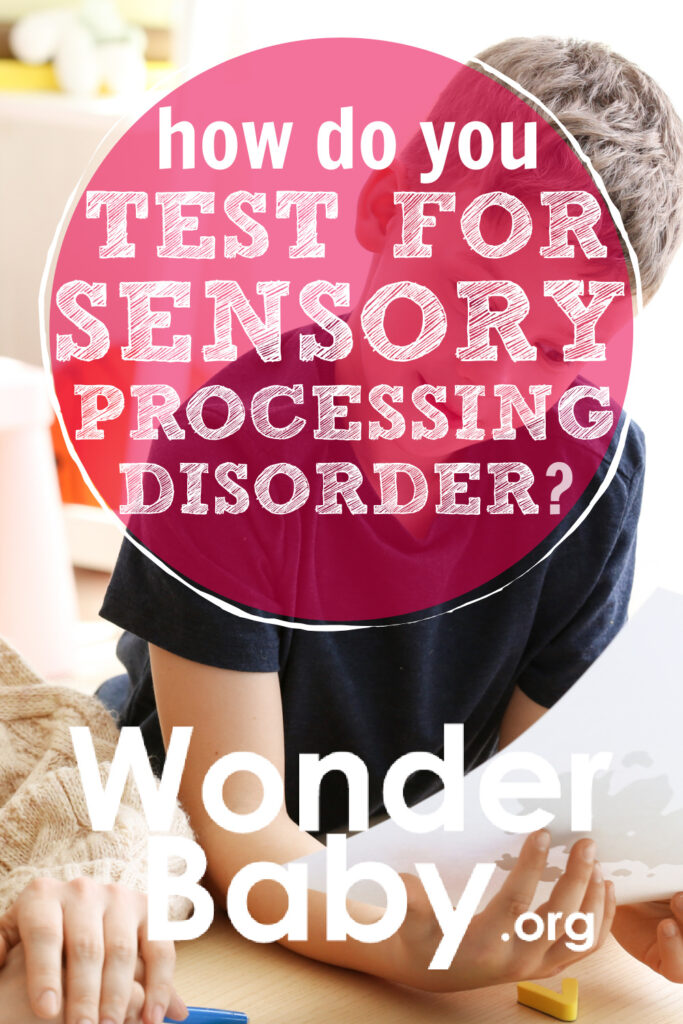How Do You Test for Sensory Processing Disorder?

- Using a standardized process to test for sensory processing disorder can help distinguish this condition from other developmental concerns.
- Testing for sensory processing disorder involves careful evaluation from a trained professional.
- Signs of sensory processing disorder may be seen in one or more sensory systems.
- While the actual testing period may be relatively short, evaluating for sensory processing disorder may take anywhere from a few days to several weeks.
Walking on the sand during a day at the beach. Playing in grass or a mud puddle. Indulging in a favorite childhood dessert of chocolate pudding topped with crushed cookies and gummy candy.
What do all of these scenarios have in common?
For my family and others like mine, the common denominator is an intense reaction caused by sensory processing disorder.
For parents of children who don’t have this condition, the behavioral and emotional outbursts that occur as a result of sensory processing disorder can be misunderstood as our children acting “spoiled” or “overdramatic.”
I began to wonder if my child’s intense reactions to seemingly normal experiences were a result of bad behavior or a clue that something else, like sensory processing disorder, was occurring. This led to some fascinating conversations with our healthcare provider and a recommendation for a developmental assessment.
Like me, you may wonder how professionals test for sensory processing disorder and what that process involves.
What Is Sensory Processing Disorder?

According to the Child Mind Institute11. Beth Arky. Sensory Processing Disorder Explained. Child Mind Institute. 2024. https://childmind.org/article/sensory-processing-issues-explained, sensory processing disorder (SPD) refers to unusual behaviors or reactions shown by a child when they are over or under-stimulated by information relating to one or more senses.
Parents of children with SPD tend to report that they notice characteristics consistent with their child’s ability to interpret, process, and integrate data from their senses from a very young age.
These struggles usually last longer than a simple phase and may require using sensory integration strategies to successfully manage these challenges.
Sensory Processing Disorder Test: What Is It For?
Sensory processing disorder testing uses a systematic process to evaluate your child’s ability to receive, process, and interpret sensory information and how much it impacts their ability to successfully interact with their environment at home, school, or other places.
It also helps to determine whether your child’s symptoms of sensory processing disorder are part of other neurodevelopmental22. Passarello, N., Tarantino, V., Chirico, A., Menghini, D., Costanzo, F., Sorrentino, P., Fucà, E., Gigliotta, O., Alivernini, F., Oliveri, M., Lucidi, F., Vicari, S., Mandolesi, L., & Turriziani, P. . Sensory Processing Disorders in Children and Adolescents: Taking Stock of Assessment and Novel Therapeutic Tools. Brain Sciences. 2022;12(11), 1478. https://doi.org/10.3390/brainsci12111478 conditions.
How to Tell if a Child Needs to Get Tested for Sensory Processing Disorder

Staff from Columbia University’s Irving Medical Center33. Sensory Processing Disorder. Sensory Processing Disorder Information & Treatment. https://www.columbiadoctors.org/health-library/condition/sensory-processing-disorder report that a child may need to be evaluated for SPD if they consistently show characteristics of a decreased or exaggerated response to stimulation involving one or more of their senses.
Consider the need for sensory processing disorder testing if your child shows signs like:
- Constant motion, tiring easily, or frequently moving back and forth between both states.
- Strong preference or aversion to touch.
- Aversion to eating specific foods because of how the food feels in their mouth.
- Refusal to sit at the table when certain foods are served because of their smell.
- Oversensitivity to other (non-food) odors.
- Showing strong preferences or unwillingness to wear or touch certain fabrics or only wearing specific types of clothing.
- Strong dislike of getting their hands dirty in mud, clay, grass, or food.
- Avoiding specific movements like swinging, sliding, or maneuvering down ramps or other inclines.
- Difficulty with gross motor skills like climbing or moving up or down stairs.
- Showing difficulty calming down after vigorous physical movement or after becoming upset.
- Excessive movement (jumping, swinging, spinning, etc.).
- Appearing to have poor balance (tripping easily or appearing clumsy).
- Consistently odd posture.
- Showing difficulty with fine motor control in tasks like maneuvering buttons or snaps (beyond what may be normal for your child’s age).
- Showing exaggerated responses (like tantrums or screaming) to sounds like sirens, the dishwasher, vacuum cleaners, or lawnmowers.
- Limited creativity or variety in play (may show rigidity in certain toys being played with in a specific manner or only wants to watch TV, videos, or digital media.)
Contact your child’s healthcare provider if you have concerns about your child’s sensory processing abilities.
Only a qualified professional can accurately diagnose sensory processing disorder.
What to Expect During a Sensory Processing Disorder Test

An evaluation for sensory processing disorder generally includes three separate pieces.
Parent Evaluations
Parents, teachers, or frequent caregivers may be asked to complete a series of questionnaires describing a child’s behavior under various circumstances.
This allows clinicians to have an overall picture of your child as they move through their day and identify certain times or specific situations in which your child has difficulty.
Standardized Testing
Using assessment tools, such as the Sensory Integration and Praxis Test44. Sensory Integration and Praxis Test. Texas Education Agency. https://www.txautism.net/evaluations/sensory-integration-and-praxis-test (SIPT) or Sensory Profile55. Peterson, C.. What Is Your Child’s Sensory Profile? (And Why It’s Critical to Know). ADDitude. 2024. https://www.additudemag.com/sensory-processing-problems-profile-adhd, allows the provider to determine your child’s sensory abilities objectively.
These include evaluating the senses of sight, sound, touch, balance, and movement.
Provider Observations
In most instances, sensory processing disorder testing will be carried out by someone with specific training in childhood movement and behavior disorders.
These can include professionals such as a pediatrician, a mental health professional, or a pediatric occupational therapist.
How Long Does a Sensory Processing Disorder Test Last?

Generally speaking, testing for sensory processing disorder happens in four stages.
Gathering Data
Parents, teachers, or caregivers complete the assessment tools requested by the testing provider and submit their questionnaires before their child’s appointment.
Parent Interview
Parents meet with the professional who will conduct their child’s evaluation for sensory processing disorder anywhere from several days before the testing to immediately before their child’s time with the provider.
The professional will ask structured questions about your child’s typical responses in various situations and clarify any questions after a review of the questionnaires.
Child Observation
The provider meets with your child and observes their responses as they move through various testing scenarios.
Parents usually aren’t present during this stage, in case their presence impacts their child’s usual responses.
This portion can last anywhere from one to three hours, depending on your child’s ability to complete sensory processing disorder testing in one sitting,
Results
Parents meet with the testing provider after all parts of the testing have been completed and the provider has had time to review and interpret their findings.
The entire process may take anywhere from a few days to several weeks, depending on the provider, the length of time required for your child to complete all portions of the assessment, and the amount of time the provider needs to create treatment recommendations.
What Happens After a Sensory Processing Test?

The provider that conducted your child’s SPD testing will usually share ideas about the next steps for your child and help you identify areas that pose the greatest concern for your child’s overall health, well-being, and development.
Depending on the testing results and goals you identify, the provider may suggest that you consider using the services of a physical therapist, speech/language therapist, occupational therapist, or other professional to help your child progress toward treatment goals.
While the symptoms of sensory processing disorder can vary widely and appear mysterious, the process of determining the extent to which any sensory challenges impact your child’s health and development is fairly straightforward. The provider who conducts your child’s sensory processing disorder testing will likely work with you and your child to identify the next steps that can help your child manage or resolve these struggles.
References
- Beth Arky. (2024, November 20). Sensory Processing Disorder Explained. Child Mind Institute. https://childmind.org/article/sensory-processing-issues-explained
- Passarello, N., Tarantino, V., Chirico, A., Menghini, D., Costanzo, F., Sorrentino, P., Fucà, E., Gigliotta, O., Alivernini, F., Oliveri, M., Lucidi, F., Vicari, S., Mandolesi, L., & Turriziani, P. (2022). Sensory Processing Disorders in Children and Adolescents: Taking Stock of Assessment and Novel Therapeutic Tools. Brain Sciences, 12(11), 1478. https://doi.org/10.3390/brainsci12111478
- Sensory Processing Disorder. Sensory Processing Disorder Information & Treatment. (n.d.). https://www.columbiadoctors.org/health-library/condition/sensory-processing-disorder
- Sensory Integration and Praxis Test. Texas Education Agency. (n.d.). https://www.txautism.net/evaluations/sensory-integration-and-praxis-test
- Peterson, C. (2024, June 11). What Is Your Child’s Sensory Profile? (And Why It’s Critical to Know). ADDitude. https://www.additudemag.com/sensory-processing-problems-profile-adhd

The information WonderBaby provides is not intended to be, and does not constitute, medical or other health advice or diagnosis and should not be used as such. Always consult with a qualified medical professional about your specific circumstances.
Related Posts

Eye Conditions and Syndromes, Visual Impairment
Neuralink Announces Plans to Restore Sight to the Blind with Brain Chip
Elon Musk’s company Neuralink has announced plans to begin human trials of its new “Blindsight” brain chip by the end of 2025.

Special Needs
5 Spring Cleaning Tips for Families of Children with Disabilities
Spring cleaning is an opportunity to create a more accessible, organized, and supportive space for your child with disabilities. Declutter, deep clean, and refresh!

Visual Impairment
The Gift of Understanding: How a Young Child Helps His Blind Father Navigate Life
When a parent is blind, it’s natural for people to wonder how their sighted child will adapt. Will they struggle to understand their parent’s needs? Will they feel burdened by...